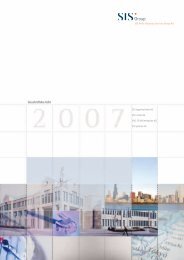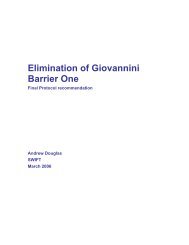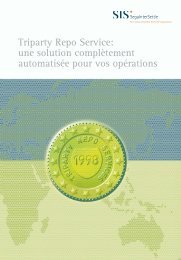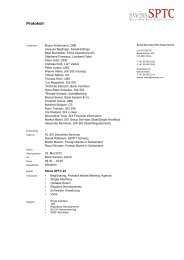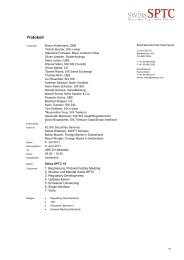Market Standards for Corporate Actions Processing - SIX Securities ...
Market Standards for Corporate Actions Processing - SIX Securities ...
Market Standards for Corporate Actions Processing - SIX Securities ...
You also want an ePaper? Increase the reach of your titles
YUMPU automatically turns print PDFs into web optimized ePapers that Google loves.
Final and endorsed version 2009<br />
<strong>Market</strong> <strong>Standards</strong> <strong>for</strong> <strong>Corporate</strong> <strong>Actions</strong> <strong>Processing</strong><br />
1
Table of contents<br />
Introduction 3<br />
Glossary 6<br />
Sequence of dates graphs 10<br />
Distributions<br />
Cash Distributions 11<br />
<strong>Securities</strong> Distributions 16<br />
Distributions with Options 21<br />
Reorganisations<br />
Mandatory Reorganisations with Options 24<br />
Mandatory Reorganisations 29<br />
Voluntary Reorganisations 34<br />
Transaction Management 39<br />
<strong>Market</strong> Claims 41<br />
Trans<strong>for</strong>mations 43<br />
Buyer Protection 45<br />
Annex 1: Members of the <strong>Corporate</strong> <strong>Actions</strong> Joint Working Group 47<br />
2
Introduction<br />
In the Giovannini Reports corporate actions processing is dealt with as Barrier 3, where, referring to the existing national differences,<br />
the operational problems are characterised by “the variety of rules, in<strong>for</strong>mation requirements and deadlines <strong>for</strong> corporate actions.<br />
These differences may require specialised local knowledge or the lodgement of physical documents locally, and so inhibit the<br />
centralisation of securities settlement.”<br />
<strong>Corporate</strong> actions processing is deemed one of the most complex areas of post trading. Standardising these processes across all<br />
European markets, and possibly beyond, aims at achieving a significant reduction of respective costs and operational risks. To<br />
dismantle Giovannini Barrier 3, investments may be required in order to become compliant with the standards on corporate actions<br />
processing. However, upon implementation of the standards, the European securities market and its users will benefit from cost<br />
savings resulting from harmonising the processes cross border.<br />
Individual work of associations contributing to the dismantling of Giovannini Barrier 3 was replaced in summer 2007 by the set up of<br />
the <strong>Corporate</strong> <strong>Actions</strong> Joint Working Group (CAJWG) 1 that encompasses the main relevant constituencies, i.e. Issuers, market<br />
infrastructures and intermediaries. The CAJWG’s objective has been to develop a comprehensive set of market standards <strong>for</strong><br />
the operational processing of all categories of corporate actions 2 including transaction management.<br />
This document contains the standards proposed by the CAJWG, reviewed in the 1 st quarter 2009 in consideration of the responses to<br />
the market consultation of the 4 th quarter 2008 and endorsed by the involved associations: EuropeanIssuers, European Central<br />
<strong>Securities</strong> Depositories Association (ECSDA), European Association of Clearing Houses (EACH), Federation of European <strong>Securities</strong><br />
Exchanges (FESE), European Banking Federation (EBF), European Association of Cooperative Banks (EACB), European Savings<br />
Banks Group (ESBG), European <strong>Securities</strong> Services Forum (ESSF/SIFMA).<br />
1 See Annex 1<br />
2 Except <strong>for</strong> general meetings that is the subject of the Joint Working Group on General Meetings<br />
3
The CAJWG has agreed on basic principles whereby the standards should be based on work already per<strong>for</strong>med and should reflect<br />
future best market practices (rather than solutions currently applied in most markets) that, once implemented, should dismantle the<br />
operational part of Barrier 3 as concerns the categories of <strong>Corporate</strong> <strong>Actions</strong> addressed.<br />
The proposed market standards cover the following categories of <strong>Corporate</strong> <strong>Actions</strong> (rather than individual event types) as well as<br />
transaction management:<br />
• Distributions<br />
o Distributions:<br />
Cash Distributions (e.g. cash dividend, interest payment)<br />
<strong>Securities</strong> Distributions (e.g. stock dividend, bonus issue)<br />
o Distributions with Options (e.g. optional dividend)<br />
• Reorganisations<br />
o Mandatory Reorganisations with Options (e.g. conversion)<br />
o Mandatory Reorganisations (e.g. stock split, redemption)<br />
o Voluntary Reorganisations (e.g. tender offer)<br />
• Transaction Management<br />
o <strong>Market</strong> Claims (Distributions)<br />
o Trans<strong>for</strong>mations (Reorganisations)<br />
o Buyer Protection (Elective <strong>Corporate</strong> <strong>Actions</strong>)<br />
The scope of application of the proposed market standards includes<br />
• all types of the above categories of <strong>Corporate</strong> <strong>Actions</strong> (Distributions and Reorganisations)<br />
• all securities deposited and settled in Book Entry <strong>for</strong>m with an (I)CSD in Europe<br />
• all parties involved, i.e. Issuers, market infrastructures (trading, clearing and settlement), Intermediaries and End Investors,<br />
except <strong>for</strong> standards <strong>for</strong> transaction management which are directed at market infrastructures and Intermediaries only.<br />
4
The subject matter of the standards concerns<br />
• the in<strong>for</strong>mation flow throughout the chain of relevant parties<br />
• key dates and their sequence<br />
• the operational processing of <strong>Corporate</strong> <strong>Actions</strong>.<br />
It is important to note that, within the standards, entitlements are determined from the actual settled positions in the Issuer (I)CSD’s<br />
books on Record Date, whereas Intermediaries may calculate on a contractual settlement basis on Ex Date.<br />
The CAJWG takes the view that in order to reap the full benefits of the proposed standards the harmonisation of<br />
Settlement Cycles in Europe is required. However, the implementation of the proposed standards should not be delayed in the<br />
absence thereof.<br />
5
Glossary<br />
Note: Definitions given in this glossary are <strong>for</strong> the purpose of the standards on <strong>Corporate</strong> <strong>Actions</strong> only and are not intended to have<br />
any legal connotations or to reflect current market practices.<br />
Actual Settlement Date Date on which the settlement effectively takes place.<br />
Bilateral Input Instructions submitted by both parties to settlement as opposed to direct input, which is<br />
submitted by third parties.<br />
Book Entry Accounting of securities and other financial assets in dematerialised or immobilised <strong>for</strong>m.<br />
Business Day Business day at the Issuer (I)CSD.<br />
Buyer Protection Process whereby a buyer who has yet to receive the Underlying <strong>Securities</strong> of an Elective<br />
<strong>Corporate</strong> Action, instructs the seller in order to receive the outturn of his choice.<br />
Buyer Protection Deadline Last day and time by which a Buyer Protection instruction can be given.<br />
CCP Central counterparty, i.e. an entity that interposes itself between the two parties to a trade,<br />
becoming the buyer to every seller and the seller to every buyer.<br />
Cash Distribution A Distribution where the proceeds consist of cash only.<br />
Chain of Intermediaries Sequence of Intermediaries connecting the Issuer / Issuer CSD with the End Investor and vice<br />
versa in respect of securities held by Book Entry in a securities account.<br />
<strong>Corporate</strong> Action Action initiated upon a security by the Issuer or an Offeror.<br />
Distribution <strong>Corporate</strong> Action whereby the Issuer of a security delivers particular proceeds to the holder of<br />
the Underlying Security without affecting the Underlying Security.<br />
6
Distribution with Options A Distribution with a choice of proceeds.<br />
Election Period Period during which elections can be made.<br />
Elective <strong>Corporate</strong> Action Distribution with Options, Mandatory Reorganisation with Options or Voluntary Reorganisation.<br />
End Investor Physical or legal person who holds the security <strong>for</strong> his own account, not including the holder of<br />
a unit of a UCIT (undertaking <strong>for</strong> collective investments in transferable securities).<br />
Ex Date Date from which the Underlying Security is traded without the benefit / right attached to it.<br />
Fractions The number of Underlying <strong>Securities</strong> remaining after the calculation of the entitlement to the<br />
proceeds of a <strong>Corporate</strong> Action.<br />
or<br />
The decimal part of the balance of outturn securities resulting from the calculation of the<br />
proceeds of a <strong>Corporate</strong> Action.<br />
Guaranteed Participation Date Last date to buy the Underlying Security with the right attached to participate in an Elective<br />
<strong>Corporate</strong> Action.<br />
(I)CSD (International) Central <strong>Securities</strong> Depository<br />
Intended Settlement Date Date on which a Transaction is due to settle.<br />
Interim Security Short term transferable operational instrument, issued <strong>for</strong> processing purposes only, which is<br />
not representative of the Issuer’s capital.<br />
Intermediaries Financial institutions that provide and maintain securities accounts.<br />
Investor (I)CSD (I)CSD that holds securities with another (I)CSD or with an Intermediary.<br />
ISIN International <strong>Securities</strong> Identification Number<br />
7
ISO International Organization <strong>for</strong> Standardisation<br />
Issuer The issuer of an Underlying Security including the agent mandated by the Issuer <strong>for</strong> <strong>Corporate</strong><br />
<strong>Actions</strong> purposes.<br />
Issuer (I)CSD (I)CSD with whom the Issuer has deposited and maintains its primary securities issuance by<br />
Book Entry.<br />
Mandatory Reorganisation A Reorganisation that mandatorily affects the Underlying Security.<br />
Mandatory Reorganisation A Mandatory Reorganisation with a choice of proceeds.<br />
with Options<br />
<strong>Market</strong> Claim Process to reallocate the proceeds of a Distribution to the contractually entitled party.<br />
<strong>Market</strong> Deadline Last date and time, preferably end of day, to send election instructions to the Issuer (I)CSD.<br />
Matching Process of comparing the two relevant settlement instructions as provided by the two<br />
counterparties to ensure that they match.<br />
Offeror Party (other than the Issuer) including its agent, offering a Voluntary Reorganisation.<br />
Payment Delivery of the proceeds of a <strong>Corporate</strong> Action.<br />
Payment Date Date on which the Payment is due.<br />
Pending Transaction Unsettled Transaction.<br />
Record Date Date on which settled positions are struck in the books of the Issuer (I)CSD at close of<br />
business to determine the entitlement to the proceeds of a <strong>Corporate</strong> Action.<br />
Reorganisation A <strong>Corporate</strong> Action whereby the Underlying Security is replaced with proceeds.<br />
8
<strong>Securities</strong> Distribution A Distribution where the proceeds consist of securities.<br />
Settlement Cycle Number of Business Days from the trade date to the Intended Settlement Date.<br />
Transaction The result of Matching.<br />
Trans<strong>for</strong>mation Process by which Pending Transactions, on or after Record Date / <strong>Market</strong> Deadline, are<br />
cancelled and replaced by new Transactions in accordance with the terms of the<br />
Reorganisation.<br />
Underlying Security Security that is the subject of a <strong>Corporate</strong> Action.<br />
Underlying Transaction Transaction upon which a <strong>Market</strong> Claim, Trans<strong>for</strong>mation or Buyer Protection is applied.<br />
Voluntary Reorganisation A Reorganisation in which participation is optional <strong>for</strong> the holder of the Underlying Security.<br />
9
Sequence of dates graphs<br />
Graphs in this document are <strong>for</strong> illustrative purposes only; please refer to the standards <strong>for</strong> a detailed description of the timelines.<br />
In the absence of harmonised Settlement Cycles, the graphs in this document do not use a day-by-day timeline. They show the<br />
sequence of key dates as well as the length of intervals between key dates including the relevant daytime of these dates.<br />
10
Cash Distributions<br />
11
Cash Distributions<br />
Sequence of dates<br />
minimum two Business Days<br />
Note that the Ex Date is not applicable to securities in nominal, e.g. bonds<br />
Settlement Cycle minus one Business Day<br />
12<br />
preferably one Business Day
<strong>Market</strong> <strong>Standards</strong> <strong>for</strong> Cash Distributions<br />
In<strong>for</strong>mation from Issuer to Issuer (I)CSD<br />
1. The Issuer should in<strong>for</strong>m its Issuer (I)CSD of the details of a Cash Distribution, including the key dates, as soon as the Issuer<br />
has publicly announced the <strong>Corporate</strong> Action according to applicable law. It should also in<strong>for</strong>m the Issuer (I)CSD of any change<br />
or confirmation of the <strong>Corporate</strong> Action.<br />
2. For floating rate instruments, the Payment Date confirmation and the announcement of the next applicable rate with reference<br />
to the applicable period <strong>for</strong> that new rate should be made in two separate announcements and not combined in the same.<br />
3. The in<strong>for</strong>mation should be communicated in <strong>for</strong>matted electronic <strong>for</strong>m using standards defined and used by the securities<br />
industry, such as the ISO standards, irrespective of the communication channel used.<br />
4. For narrative text in the in<strong>for</strong>mation, Issuers with an international shareholder base should use at least a language customary in<br />
the sphere of international finance, currently English.<br />
In<strong>for</strong>mation from Issuer (I)CSD to its participants<br />
5. The Issuer (I)CSD should communicate the in<strong>for</strong>mation, and any subsequent in<strong>for</strong>mation, without undue delay of receipt from<br />
the Issuer, to all its participants 1 who, at the time of the announcement, have a direct holding or Pending Transaction in the<br />
Underlying Security with the Issuer (I)CSD.<br />
6. The Issuer (I)CSD should also in<strong>for</strong>m, without undue delay, any participant who obtains a holding or is subject to a new<br />
Transaction on the Underlying Security after the announcement until the Record Date.<br />
7. The in<strong>for</strong>mation should be communicated in <strong>for</strong>matted electronic <strong>for</strong>m using standards defined and used by the securities<br />
industry, such as the ISO standards, irrespective of the communication channel used.<br />
8. If a Payment needs to be reversed, an announcement, including the reason <strong>for</strong> such reversal, should be made by the Issuer<br />
(I)CSD to all affected parties prior to processing the reversal.<br />
1 Including Investor (I)CSDs<br />
13
In<strong>for</strong>mation flow from (I)CSD participants to End Investors<br />
9. (I)CSD participants, their clients and the onward Chain of Intermediaries, each at its respective level towards its own clients,<br />
should comply with standards 5 and 6 above until the in<strong>for</strong>mation reaches the End Investor. For End Investors, in<strong>for</strong>mation by<br />
means of account statement is deemed sufficient unless provided otherwise in their service level agreement.<br />
10. The in<strong>for</strong>mation should be communicated to Intermediaries in <strong>for</strong>matted electronic <strong>for</strong>m using standards defined and used by<br />
the securities industry, such as the ISO standards, irrespective of the communication channel used.<br />
11. The in<strong>for</strong>mation should be communicated to non-Intermediaries, including End Investors, in a clear and comprehensible way.<br />
12. Key dates are:<br />
Key dates<br />
a) <strong>for</strong> Distributions relating to securities in nominal (e.g. bonds): Record Date and Payment Date.<br />
b) <strong>for</strong> Distributions relating to securities in units (e.g. shares): Ex Date, Record Date and Payment Date.<br />
13. The public announcement by the Issuer under standard 1 above should be made at least two Business Days be<strong>for</strong>e the Ex<br />
Date.<br />
14. For floating rate instruments, the payable rate should be confirmed as soon as possible but no later than three Business Days<br />
be<strong>for</strong>e the Payment Date.<br />
15. The Ex Date should precede the Record Date by one Settlement Cycle minus one Business Day.<br />
16. The Payment Date should be as close as possible to the Record Date, preferably the next Business Day.<br />
14
<strong>Processing</strong><br />
17. Payments should be by Book Entry.<br />
18. Interest Payments should be processed separately from redemptions even if their Payment Dates coincide.<br />
19. All Cash Distributions and related <strong>Market</strong> Claims should be paid in cash and not coupons.<br />
20. For Payments, the following should apply:<br />
a) From Issuers to (I)CSD participants, Payments should be made through the Issuer (I)CSD, using the same Payment<br />
mechanism as <strong>for</strong> other cash transactions through the Issuer (I)CSD.<br />
b) Payments by Issuers and Issuer (I)CSDs should be in the original currency as per the announcement under standard 1<br />
above.<br />
c) The Issuer should make Payments as early as possible after opening of the Payment system and no later than 12:00 noon<br />
Issuer (I)CSD local time.<br />
d) No blocking of holdings <strong>for</strong> the purpose of Cash Distributions.<br />
e) If a correction of the Payment is necessary, it should take the <strong>for</strong>m of a complete reversal of the Payment followed by a new<br />
correct Payment.<br />
15
<strong>Securities</strong> Distributions<br />
16
<strong>Securities</strong> Distributions<br />
Sequence of dates<br />
minimum two Business Days<br />
Settlement Cycle minus one Business Day<br />
17<br />
One Business Day
<strong>Market</strong> <strong>Standards</strong> <strong>for</strong> <strong>Securities</strong> Distributions<br />
In<strong>for</strong>mation from Issuer to Issuer (I)CSD<br />
1. The Issuer should in<strong>for</strong>m its Issuer (I)CSD of the details of a <strong>Securities</strong> Distribution, including the key dates and the ISIN of the<br />
outturn security, as soon as the Issuer has publicly announced the <strong>Corporate</strong> Action according to applicable law. It should also<br />
in<strong>for</strong>m the Issuer (I)CSD of any change or confirmation of the <strong>Corporate</strong> Action and, if applicable, of the reference price <strong>for</strong><br />
compensation of Fractions by the Issuer.<br />
2. The in<strong>for</strong>mation should be communicated in <strong>for</strong>matted electronic <strong>for</strong>m using standards defined and used by the securities<br />
industry, such as the ISO standards, irrespective of the communication channel used.<br />
3. For narrative text in the in<strong>for</strong>mation, Issuers with an international shareholder base should use at least a language customary in<br />
the sphere of international finance, currently English.<br />
In<strong>for</strong>mation from Issuer (I)CSD to its participants<br />
4. The Issuer (I)CSD should communicate the in<strong>for</strong>mation, and any subsequent in<strong>for</strong>mation, without undue delay of receipt from<br />
the Issuer, to all its participants 1 who, at the time of the announcement, have a direct holding or Pending Transaction in the<br />
Underlying Security with the Issuer (I)CSD.<br />
5. The Issuer (I)CSD should also in<strong>for</strong>m, without undue delay, any participant who obtains a holding or is subject to a new<br />
Transaction on the Underlying Security after the announcement until the Record Date.<br />
6. The in<strong>for</strong>mation should be communicated in <strong>for</strong>matted electronic <strong>for</strong>m using standards defined and used by the securities<br />
industry, such as the ISO standards, irrespective of the communication channel used.<br />
7. If a Payment needs to be reversed, an announcement, including the reason <strong>for</strong> such reversal, should be made by the Issuer<br />
(I)CSD to all affected parties prior to processing the reversal.<br />
1 Including Investor (I)CSDs<br />
18
In<strong>for</strong>mation flow from (I)CSD participants to End Investors<br />
8. (I)CSD participants, their clients and the onward Chain of Intermediaries, each at its respective level towards its own clients,<br />
should comply with standards 4 and 5 above until the in<strong>for</strong>mation reaches the End Investor. For End Investors, in<strong>for</strong>mation by<br />
means of account statement is deemed sufficient unless provided otherwise in their service level agreement.<br />
9. The in<strong>for</strong>mation should be communicated to Intermediaries in <strong>for</strong>matted electronic <strong>for</strong>m using standards defined and used by<br />
the securities industry, such as the ISO standards, irrespective of the communication channel used.<br />
10. The in<strong>for</strong>mation should be communicated to non-Intermediaries, including End Investors, in a clear and comprehensible way.<br />
Key dates<br />
11. Key dates are Ex Date, Record Date and Payment Date.<br />
12. The public announcement by the Issuer under standard 1 above should be made at least two Business Days be<strong>for</strong>e the Ex<br />
Date.<br />
13. The Ex Date should precede the Record Date by one Settlement Cycle minus one Business Day.<br />
14. The Payment Date should be the next Business Day after Record Date.<br />
<strong>Processing</strong><br />
15. Payments should be by Book Entry.<br />
16. For Payments in securities, the following should apply:<br />
a) The Issuer should make Payments through the (I)CSD as early as possible and no later than the opening of the settlement<br />
system <strong>for</strong> settlement on the relevant Payment Date.<br />
b) The Payments should be processed by rounding down to the nearest whole number (top-down method).<br />
c) When Fractions occur and the Issuer compensates them in cash at the level of the Issuer (I)CSD, the Issuer (I)CSD<br />
participants and all the Intermediaries down the chain should on their turn, each at its respective level, also compensate any<br />
Fractions in cash.<br />
19
17. For Payments of Fractions in cash, where applicable, the following should apply:<br />
a) From Issuers to (I)CSD participants, Payments should be made through the Issuer (I)CSD, using the same Payment<br />
mechanism as <strong>for</strong> other cash transactions through the Issuer (I)CSD.<br />
b) Payments by Issuers and Issuer (I)CSDs should be in the original currency as per the announcement under standard 1<br />
above.<br />
c) The Issuer should make Payments as early as possible after opening of the Payment system and no later than 12:00 noon<br />
Issuer (I)CSD local time.<br />
d) If a correction of the Payment is necessary, it should take the <strong>for</strong>m of a complete reversal of the Payment followed by a new<br />
correct Payment.<br />
20
Distributions with Options<br />
21
Distributions with Options<br />
Overall sequence of dates<br />
minimum two Business Days<br />
Distribution<br />
Settlement Cycle minus one Business Day<br />
One Business Day<br />
minimum fifteen Business Days<br />
Mandatory Reorganisation with Options<br />
Minimum ten Business Days<br />
Settlement Cycle plus two hours<br />
22<br />
minimum one Business Day<br />
preferably one Business Day
<strong>Market</strong> <strong>Standards</strong> <strong>for</strong> Distributions with Options<br />
1. Distributions with Options should be represented by an Interim Security with an official ISIN.<br />
2. The issuance of the Interim Security and the options attached to it should be operationally treated as two separate <strong>Corporate</strong><br />
<strong>Actions</strong>, the first being a Distribution, the second a Mandatory Reorganisation with Options (or a Voluntary Reorganisation).<br />
They should be communicated to the Issuer (I)CSD at the same time and the second <strong>Corporate</strong> Action type should be indicated<br />
in the in<strong>for</strong>mation of the first <strong>Corporate</strong> Action.<br />
3. The standards <strong>for</strong> <strong>Securities</strong> Distributions should apply to the first <strong>Corporate</strong> Action, i.e. the Distribution.<br />
4. The standards <strong>for</strong> Mandatory Reorganisations with Options (or Voluntary Reorganisations) should apply to the second<br />
<strong>Corporate</strong> Action, i.e. the Mandatory Reorganisation with Options (or the Voluntary Reorganisation).<br />
5. The Election Period determined by the Issuer should not start be<strong>for</strong>e the Payment Date of the Interim Security.<br />
6. The Intended Settlement Date of any Transaction in the Interim Security should not be prior to the Payment Date of the Interim<br />
Security.<br />
23
Mandatory Reorganisations with Options<br />
24
Mandatory Reorganisations with Options<br />
Sequence of dates<br />
minimum two Business Days<br />
minimum ten Business Days<br />
Settlement Cycle plus two hours<br />
25<br />
minimum one Business Day<br />
preferably one Business Day
<strong>Market</strong> <strong>Standards</strong> <strong>for</strong> Mandatory Reorganisations with Options<br />
In<strong>for</strong>mation from Issuer to Issuer (I)CSD<br />
1. The Issuer should in<strong>for</strong>m its Issuer (I)CSD of the details of a Mandatory Reorganisation with Options, including the key dates<br />
and the Issuer default option, as soon as the Issuer has publicly announced the <strong>Corporate</strong> Action according to applicable law. It<br />
should in<strong>for</strong>m the Issuer (I)CSD also in case of a change or confirmation of the <strong>Corporate</strong> Action and, if applicable, of the<br />
reference price <strong>for</strong> compensation of Fractions by the Issuer.<br />
2. The in<strong>for</strong>mation should be communicated in <strong>for</strong>matted electronic <strong>for</strong>m using standards defined and used by the securities<br />
industry, such as the ISO standards, irrespective of the communication channel used.<br />
3. For narrative text in the in<strong>for</strong>mation, Issuers with an international shareholder base should use at least a language customary in<br />
the sphere of international finance, currently English.<br />
In<strong>for</strong>mation from Issuer (I)CSD to its participants<br />
4. The Issuer (I)CSD should communicate the in<strong>for</strong>mation, and any subsequent in<strong>for</strong>mation, without undue delay of receipt from<br />
the Issuer, to all its participants 1 who, at the time of the announcement, have a direct holding or Pending Transaction in the<br />
Underlying Security with the Issuer (I)CSD.<br />
5. The Issuer (I)CSD should also in<strong>for</strong>m, without undue delay, any participant who obtains a holding or is subject to a new<br />
Transaction on the Underlying Security after the announcement until the <strong>Market</strong> Deadline.<br />
6. The in<strong>for</strong>mation should be communicated in <strong>for</strong>matted electronic <strong>for</strong>m using standards defined and used by the securities<br />
industry, such as the ISO standards, irrespective of the communication channel used.<br />
7. If a Payment needs to be reversed, an announcement, including the reason <strong>for</strong> such reversal, should be made by the Issuer<br />
(I)CSD to all affected parties prior to processing the reversal.<br />
1 Including Investor (I)CSDs<br />
26
In<strong>for</strong>mation flow from (I)CSD participants to End Investors<br />
8. (I)CSD participants, their clients and the onward Chain of Intermediaries, each at its respective level towards its own clients,<br />
should comply with standards 4 and 5 above until the in<strong>for</strong>mation reaches the End Investor.<br />
9. The in<strong>for</strong>mation should be communicated to Intermediaries in <strong>for</strong>matted electronic <strong>for</strong>m using standards defined and used by<br />
the securities industry, such as the ISO standards, irrespective of the communication channel used.<br />
10. The in<strong>for</strong>mation should be communicated to non-Intermediaries, including End Investors, in a clear and comprehensible way.<br />
Key dates<br />
11. The public announcement by the Issuer under standard 1 above should be made at least two Business Days be<strong>for</strong>e the start of<br />
the Election Period.<br />
12. The start of the Election Period as determined by the Issuer should be at least ten Business Days be<strong>for</strong>e the <strong>Market</strong> Deadline 1 .<br />
13. The Guaranteed Participation Date should precede the Buyer Protection Deadline by one Settlement Cycle plus two hours 2 .<br />
14. The Buyer Protection Deadline should be at least one Business Day be<strong>for</strong>e the <strong>Market</strong> Deadline.<br />
15. The Payment Date of the elected Option should be as close as possible to the <strong>Market</strong> Deadline, preferably the next Business<br />
Day.<br />
<strong>Processing</strong><br />
16. Payments should be by Book Entry.<br />
17. An ISIN that is different from the ISIN of the Underlying Security should be allocated to each outturn security.<br />
18. Each option should have a unique identifier provided by the Issuer, that will be maintained by the Issuer (I)CSD and all<br />
Intermediaries.<br />
1 In case of multiple deadlines, the earliest deadline is meant here.<br />
2 Buyer Protection should thus still be possible <strong>for</strong> two hours after closing of settlement on the day of the Buyer Protection Deadline.<br />
27
19. Elections should be communicated from the last intermediary in the Chain of Intermediaries up to the Issuer in <strong>for</strong>matted<br />
electronic <strong>for</strong>m using standards defined and used by the securities industry such as the ISO standards, irrespective of the<br />
communication channel used.<br />
20. Underlying <strong>Securities</strong> 1 on which an election is made should be separated accounting-wise from non-elected Underlying<br />
<strong>Securities</strong> 1 by the (I)CSD and all Intermediaries.<br />
21. For non-elected Underlying <strong>Securities</strong> 1 , the default option as announced by the Issuer should apply.<br />
22. For Payments in cash, the following should apply:<br />
a) From Issuers to (I)CSD participants, Payments should be made through the Issuer (I)CSD, using the same Payment<br />
mechanism as <strong>for</strong> other cash transactions through the Issuer (I)CSD.<br />
b) Payments by Issuers and Issuer (I)CSDs should be in the original currency as per the announcement under standard 1<br />
above.<br />
c) The Issuer should make Payments as early as possible after opening of the Payment system and no later than 12:00 noon,<br />
Issuer (I)CSD local time.<br />
d) If a correction of the Payment is necessary, it should take the <strong>for</strong>m of a complete reversal of the Payment followed by a new<br />
correct Payment.<br />
23. For Payments in securities, the following should apply:<br />
a) The Issuer should make Payments to the (I)CSD as early as possible and no later than the opening of the settlement system<br />
<strong>for</strong> settlement on the relevant Payment Date.<br />
b) The Payments should be processed by rounding down to the nearest whole number (top-down method).<br />
c) When Fractions occur and the Issuer compensates them in cash at the level of the Issuer (I)CSD, the Issuer (I)CSD<br />
participants and all the Intermediaries down the chain should on their turn, each at its respective level, also compensate any<br />
Fractions in cash.<br />
1 Interim Security in case the Mandatory Reorganisation with Option is the second <strong>Corporate</strong> Action in a Distribution with Options.<br />
28
Mandatory Reorganisations<br />
29
Mandatory Reorganisations<br />
Sequence of dates<br />
minimum two Business Days<br />
minimum one Settlement Cycle<br />
30<br />
preferably one Business Day
<strong>Market</strong> <strong>Standards</strong> <strong>for</strong> Mandatory Reorganisations<br />
In<strong>for</strong>mation from Issuer to Issuer (I)CSD<br />
1. The Issuer should in<strong>for</strong>m its Issuer (I)CSD of the details of a Mandatory Reorganisation, including the key dates, as soon as the<br />
Issuer has publicly announced the <strong>Corporate</strong> Action according to applicable law. It should also in<strong>for</strong>m the Issuer (I)CSD of any<br />
change or confirmation of the <strong>Corporate</strong> Action and, if applicable, the reference price <strong>for</strong> compensation of Fractions by the<br />
Issuer.<br />
2. The in<strong>for</strong>mation should be communicated in <strong>for</strong>matted electronic <strong>for</strong>m using standards defined and used by the securities<br />
industry, such as the ISO standards, irrespective of the communication channel used.<br />
3. For narrative text in the in<strong>for</strong>mation, Issuers with an international shareholder base should use at least a language customary in<br />
the sphere of international finance, currently English.<br />
In<strong>for</strong>mation from Issuer (I)CSD to participants<br />
4. The Issuer (I)CSD should communicate the in<strong>for</strong>mation, and any subsequent in<strong>for</strong>mation, without undue delay of receipt from<br />
the Issuer, to all its participants 1 who, at the time of the announcement, have a direct holding or Pending Transaction in the<br />
Underlying Security with the Issuer (I)CSD.<br />
5. The Issuer (I)CSD should also in<strong>for</strong>m, without undue delay, any participant who obtains a holding or is subject to a new<br />
Transaction on the Underlying Security after the announcement until the Record Date.<br />
6. The in<strong>for</strong>mation should be communicated in <strong>for</strong>matted electronic <strong>for</strong>m using standards defined and used by the securities<br />
industry, such as the ISO standards, irrespective of the communication channel used.<br />
7. If a Payment needs to be reversed, an announcement, including the reason <strong>for</strong> such reversal, should be made by the Issuer<br />
(I)CSD to all affected parties prior to processing the reversal.<br />
1 Including Investor (I)CSDs<br />
31
In<strong>for</strong>mation flow from (I)CSD participants to End Investors<br />
8. (I)CSD participants, their clients and the onward Chain of Intermediaries, each at its respective level towards its own clients,<br />
should comply with standards 4 and 5 above until the in<strong>for</strong>mation reaches the End Investor.<br />
9. The in<strong>for</strong>mation should be communicated to Intermediaries in <strong>for</strong>matted electronic <strong>for</strong>m using standards defined and used by<br />
the securities industry, such as the ISO standards, irrespective of the communication channel used.<br />
10. The in<strong>for</strong>mation should be communicated to non-Intermediaries, including End Investors, in a clear and comprehensible way.<br />
Key dates<br />
11. The public announcement by the Issuer under standard 1 above should be at least two Business Days be<strong>for</strong>e the last trading<br />
date as determined by the Issuer.<br />
12. The last trading date, i.e. the last date to trade the Underlying Security in the old ISIN, should precede the Record Date by at<br />
least one Settlement Cycle.<br />
13. The Payment Date should be as close as possible to the Record Date, preferably the next Business Day <strong>for</strong> cash outturns and<br />
the next Business Day <strong>for</strong> securities outturns.<br />
<strong>Processing</strong><br />
14. Payments should be by Book Entry.<br />
15. Redemptions should be processed separately from Interest Payments even if their Payment Dates coincide.<br />
16. An ISIN that is different from the ISIN of the Underlying Security should be allocated to each outturn security.<br />
32
17. For Payments in cash, the following should apply:<br />
a) From Issuers to (I)CSD participants, Payments should be made through the Issuer (I)CSD, using the same Payment<br />
mechanism as <strong>for</strong> other cash transactions through the Issuer (I)CSD.<br />
b) Payments by Issuers and Issuer (I)CSDs should be in the original currency as per the announcement under standard 1<br />
above.<br />
c) The Issuer should make Payments as early as possible after opening of the Payment system and no later than 12:00 noon,<br />
Issuer (I)CSD local time.<br />
d) If a correction of the Payment is necessary, it should take the <strong>for</strong>m of a complete reversal of the Payment followed by a new<br />
correct Payment.<br />
18. For Payments in securities, the following should apply:<br />
a) The Issuer should make Payments to the (I)CSD as early as possible and no later than the opening of the settlement system<br />
<strong>for</strong> settlement on the relevant Payment Date.<br />
b) The Payments should be processed by rounding down to the nearest whole number (top-down method).<br />
c) When Fractions occur and the Issuer compensates them in cash at the level of the Issuer (I)CSD, the Issuer (I)CSD<br />
participants and all the Intermediaries down the chain should on their turn, each at its respective level, also compensate any<br />
Fractions in cash.<br />
33
Voluntary Reorganisations<br />
34
Voluntary Reorganisations<br />
Sequence of dates<br />
minimum two Business Days<br />
minimum ten Business Days<br />
Settlement Cycle plus two hours<br />
35<br />
minimum one Business Day<br />
preferably one Business Day
<strong>Market</strong> <strong>Standards</strong> <strong>for</strong> Voluntary Reorganisations<br />
In<strong>for</strong>mation from Issuer/Offeror to Issuer (I)CSD<br />
1. The Issuer or the Offeror, as the case may be, should in<strong>for</strong>m the Issuer (I)CSD of the details of a Voluntary Reorganisation,<br />
including the key dates, as soon as the Issuer, or the Offeror, has publicly announced the <strong>Corporate</strong> Action according to<br />
applicable law. The Issuer or the Offeror, as the case may be, should also in<strong>for</strong>m the Issuer (I)CSD of any change or<br />
confirmation of the <strong>Corporate</strong> Action.<br />
2. The in<strong>for</strong>mation should be communicated in <strong>for</strong>matted electronic <strong>for</strong>m using standards defined and used by the securities<br />
industry, such as the ISO standards, irrespective of the communication channel used.<br />
3. For narrative text in the in<strong>for</strong>mation, Issuers with an international shareholder base should use at least a language customary in<br />
the sphere of international finance, currently English.<br />
In<strong>for</strong>mation from Issuer (I)CSD to its participants<br />
4. The Issuer (I)CSD should communicate the in<strong>for</strong>mation, and any subsequent in<strong>for</strong>mation, without undue delay of receipt from<br />
the Issuer or the Offeror, as the case may be, to all its participants 1 who, at the time of the announcement, have a direct holding<br />
or Pending Transaction in the Underlying Security with the Issuer (I)CSD.<br />
5. The Issuer (I)CSD should also in<strong>for</strong>m, without undue delay, any participant who obtains a holding or is subject to a new<br />
Transaction on the Underlying Security after the announcement until the <strong>Market</strong> Deadline.<br />
6. The in<strong>for</strong>mation should be communicated in <strong>for</strong>matted electronic <strong>for</strong>m using standards defined and used by the securities<br />
industry, such as the ISO standards, irrespective of the communication channel used.<br />
7. If a Payment needs to be reversed, an announcement, including the reason <strong>for</strong> such reversal, should be made by the Issuer<br />
(I)CSD to all affected parties prior to processing the reversal.<br />
1 Including Investor (I)CSDs<br />
36
In<strong>for</strong>mation flow from (I)CSD participants to End Investors<br />
8. (I)CSD participants, their clients and the onward Chain of Intermediaries, each at its respective level towards its own clients,<br />
should comply with standards 4 and 5 above until the in<strong>for</strong>mation reaches the End Investor.<br />
9. The in<strong>for</strong>mation should be communicated to Intermediaries in <strong>for</strong>matted electronic <strong>for</strong>m using standards defined and used by<br />
the securities industry, such as the ISO standards, irrespective from the communication channel used.<br />
10. The in<strong>for</strong>mation should be communicated to non-Intermediaries, including End Investors, in a clear and comprehensible way.<br />
Key dates<br />
11. The public announcement by the Issuer or the Offeror, as the case may be, under standard 1 above should be made at least<br />
two Business Days be<strong>for</strong>e the start of the Election Period as determined by the Issuer or the Offeror respectively.<br />
12. The start of the Election Period as determined by the Issuer or the Offeror, as the case may be, should be at least ten Business<br />
Days be<strong>for</strong>e the <strong>Market</strong> Deadline 1 .<br />
13. The Guaranteed Participation Date should precede the Buyer Protection Deadline by one Settlement Cycle plus two hours 2 .<br />
14. The Buyer Protection Deadline should be at least one Business Day be<strong>for</strong>e the <strong>Market</strong> Deadline.<br />
15. The Payment Date should be as close as possible to the <strong>Market</strong> Deadline, preferably the next Business Day.<br />
16. When the Voluntary Reorganisation is conditional, the Issuer or the Offeror, as the case may be, should publish the result of the<br />
elections. The results publication date should follow the <strong>Market</strong> Deadline as soon as possible, preferably the next Business<br />
Day, but be<strong>for</strong>e the Payment is made. Payment Date should preferably be one Business Day after results publication date.<br />
1 In case of multiple deadlines, the earliest deadline is meant here.<br />
2 Buyer Protection should thus still be possible <strong>for</strong> two hours after closing of settlement on the day of the Buyer Protection Deadline.<br />
37
<strong>Processing</strong><br />
17. Payments should be by Book Entry.<br />
18. An ISIN that is different from the ISIN of the Underlying Security should be allocated to each outturn security.<br />
19. Each Option should have a unique identifier provided by the Issuer or the Offeror, as the case may be, that will be maintained<br />
by the Issuer (I)CSD and all Intermediaries.<br />
20. Elections should be communicated from the last intermediary in the Chain of Intermediaries up to the Issuer or the Offeror, as<br />
the case may be, in <strong>for</strong>matted electronic <strong>for</strong>m using standards defined and used by the securities industry such as the ISO<br />
standards, irrespective of the communication channel used.<br />
21. <strong>Securities</strong> on which an election is made should be separated accounting-wise by the (I)CSD and all Intermediaries from nonelected<br />
securities.<br />
22. For Payments in cash, the following should apply:<br />
a) From Issuers or Offerors to (I)CSD participants, Payments should be made through the Issuer (I)CSD using the same<br />
Payment mechanism as <strong>for</strong> other cash transactions through the Issuer (I)CSD.<br />
b) Payments by Issuers, Offerors and Issuer (I)CSDs should be in the original currency as per the announcement under<br />
standard 1 above.<br />
c) The Issuer or the Offeror, as the case may be, should make Payments as early as possible after opening of the Payment<br />
system and no later than 12:00 noon Issuer (I)CSD local time.<br />
d) If a correction of the Payment is necessary, it should take the <strong>for</strong>m of a complete reversal of the Payment followed by a new,<br />
correct Payment.<br />
23. For Payments in securities the Issuer or the Offeror, as the case may be, should make Payments to the Issuer (I)CSD as early<br />
as possible and no later than the opening of the settlement system <strong>for</strong> settlements on the relevant Payment Date.<br />
38
Transaction Management<br />
Transaction management provides market standards <strong>for</strong> <strong>Market</strong> Claims, Trans<strong>for</strong>mations and Buyer Protections 1 .<br />
The standards on transaction management should apply to all types of Transactions unless agreed otherwise by the parties to it.<br />
They rely on the application of and compliance with the agreed ECSDA/ESF Matching <strong>Standards</strong>. 2<br />
The standards aim at: a) enabling the automation of the transaction management processes to ensure their timely and efficient<br />
settlement; b) protecting the right of both the buyer and the seller; c) limiting the intervention of each party involved; and d) reducing<br />
the number of Transactions to be managed considering that such process requires a reconciliation ef<strong>for</strong>t.<br />
This chapter is split into 3 parts in accordance with the category of the <strong>Corporate</strong> Action:<br />
• <strong>Market</strong> claim resulting from a Distribution<br />
• Trans<strong>for</strong>mation resulting from a Reorganisation<br />
• Buyer Protection <strong>for</strong> an Elective <strong>Corporate</strong> Action that a buyer can use if the Transaction is still unsettled whilst the <strong>Market</strong><br />
Deadline is approaching.<br />
1 For Target2-<strong>Securities</strong> more detailed processes have been proposed by the T2S <strong>Corporate</strong> <strong>Actions</strong> Sub Group (CASG)<br />
2 https://www.ecsda.com/attachments/media_centre/press_releases/ESF%20ECSDA%20Matching%20<strong>Standards</strong>%20Oct06.doc<br />
http://essf.sifma.org/publications/documents/ESF-ECSDAMatching<strong>Standards</strong>Oct06.pdf<br />
39
The CAJWG examined the question of the fiscal status of the cash <strong>Market</strong> Claim of a Pending Transaction impacted by a Cash<br />
Distribution and consequently the exact cash amount applicable <strong>for</strong> the <strong>Market</strong> Claim. Uncertainty remains regarding the exact<br />
moment of transfer of ownership from a fiscal point of view and different approaches co-exist in Europe. The CAJWG has identified<br />
this fiscal issue but acknowledges its limitation of competence and would recommend referring it to the FISCO group (Giovannini<br />
Barrier 11). The CAJWG believes that ef<strong>for</strong>ts to improve consistency and common fiscal treatment across markets and countries are<br />
essential to reap the full benefit of the EU financial market integration. The preferred solution of the CAJWG is that the default<br />
withholding rate applied to <strong>Market</strong> Claims should be determined by the Issuer (I)CSD.<br />
40
<strong>Market</strong> <strong>Standards</strong> <strong>for</strong> <strong>Market</strong> Claims<br />
Creation<br />
1. <strong>Market</strong> Claims should be created, as a separate Transaction without changing the Underlying Transaction, by the (I)CSD or the<br />
CCP <strong>for</strong> all irrevocable settlement transactions (as defined in each market) as follows:<br />
a) For securities in units (e.g. shares);<br />
From the seller to the buyer, when trade date is be<strong>for</strong>e Ex Date and there is a Pending Transaction at close of business of<br />
Record Date; or<br />
From the buyer to the seller, when trade date is on or after Ex Date and Actual Settlement Date is on or be<strong>for</strong>e Record Date.<br />
b) For securities in nominal (e.g. bonds): from the seller to the buyer, if the Intended Settlement Date is on or be<strong>for</strong>e the Record<br />
Date but there is a Pending Transaction at close of business on Record Date.<br />
2. Concurring Bilateral Input should allow to determine whether the underlying trade is “ex” or “cum” and the (I)CSD or CCP<br />
should take this into account <strong>for</strong> the creation of a <strong>Market</strong> Claim, irrespective of the actual Ex Date.<br />
<strong>Processing</strong><br />
3. The (I)CSD or the CCP should create the <strong>Market</strong> Claims by end of Record Date or, <strong>for</strong> Transactions that become eligible <strong>for</strong> a<br />
<strong>Market</strong> Claim after Record Date, as soon as possible and not later than twenty Business Days thereafter.<br />
4. All <strong>Market</strong> Claims should be in the outturn of the Distribution to which they relate.<br />
5. The Intended Settlement Date of the <strong>Market</strong> Claim should be on the Payment Date. If it is created after the Payment Date, it<br />
should be on the earliest settlement date.<br />
6. The settlement of the <strong>Market</strong> Claim should be independent from the settlement of the Underlying Transaction to which the<br />
<strong>Market</strong> Claim relates. However, (I)CSDs should provide a user friendly tool to manage the interdependency between the <strong>Market</strong><br />
Claim and the Underlying Transaction.<br />
7. The withholding rate applied to the Distribution by the Issuer (I)CSD should also apply to the <strong>Market</strong> Claim.<br />
41
Reporting<br />
8. <strong>Market</strong> Claims should be reported as such by the (I)CSD or the CCP and any other participant down the Chain of<br />
Intermediaries, at both the time of the creation and the settlement of the <strong>Market</strong> Claim, referencing both the Distribution and the<br />
Underlying Transaction that gave rise to the <strong>Market</strong> Claim.<br />
9. The reporting should be done in <strong>for</strong>matted electronic <strong>for</strong>m using standards defined and used by the industry, such as the ISO<br />
standards, irrespective of the communication channel used.<br />
42
<strong>Market</strong> <strong>Standards</strong> <strong>for</strong> Trans<strong>for</strong>mations<br />
1. A Trans<strong>for</strong>mation should be processed <strong>for</strong> Pending Transactions on Record Date in the event of a Mandatory Reorganisation<br />
and, when a Buyer Protection has been agreed, a Voluntary Reorganisation.<br />
2. The (I)CSD or the CCP should process the Trans<strong>for</strong>mation, cancelling matched instructions still pending by the end of Record<br />
Date (“Original Transaction”) and replacing them by new matched instructions in the outturn ISIN and/or cash (“Replacement<br />
Transaction”) in accordance with the terms of the Reorganisation. The old trade date should remain unchanged in the<br />
Trans<strong>for</strong>mation.<br />
3. Opt-out facilities should be allowed <strong>for</strong> Bilateral Input if both parties agree. In case of an opt-out the Original Transaction is<br />
cancelled but no new Transaction generated.<br />
<strong>Processing</strong><br />
4. The Trans<strong>for</strong>mation should be carried out by the (I)CSD or the CCP between end of Record Date <strong>for</strong> Mandatory<br />
Reorganisations or end of <strong>Market</strong> Deadline <strong>for</strong> Voluntary Reorganisations and the opening of the securities settlement system<br />
<strong>for</strong> value next Business Day.<br />
5. For Mandatory Reorganisations settlement in the old ISIN should be discontinued after the Record Date or the <strong>Market</strong> Deadline,<br />
as applicable. Input of instruction in the old ISIN should still be possible after the Guaranteed Participation Date / last trading<br />
date <strong>for</strong> instruction with trade date be<strong>for</strong>e or on the Guaranteed Participation Date / last trading date. If such instructions match,<br />
they will automatically be trans<strong>for</strong>med. Instruction with trade date after Guaranteed Participation Date / last trading date should<br />
always be in the new ISIN.<br />
6. The Replacement Transaction should neither settle be<strong>for</strong>e the Payment Date nor be<strong>for</strong>e the Intended Settlement Date of the<br />
Underlying Transaction.<br />
7. In case of multiple outturns, each Replacement Transaction should be allowed to settle irrespective of the others.<br />
43
8. When the Reorganisation consists of the replacement of an Underlying Security by cash (typically a final redemption), the<br />
Trans<strong>for</strong>mation will result in exchanging cash against cash. To ease the reconciliation process (or <strong>for</strong> fiscal reasons), two new<br />
Transactions 1 should be created, one <strong>for</strong> the original cash amount and the other one <strong>for</strong> the cash benefit of the Reorganisation.<br />
9. When the outturns generate Fractions the number of outturn shares should be rounded down to the nearest whole number.<br />
a) When the Issuer compensates the Fractions in cash, an additional cash Transaction should be created with a cash amount<br />
equal to the number of residual Fractions multiplied by the applicable price, and credited to the buyer 2 .<br />
b) When net CCP transactions are involved in a Trans<strong>for</strong>mation process with Fractions, the CCP could adjust (when necessarily<br />
required) the number of new shares and Fractions to maintain a balance between net buyers and net sellers. The price of each<br />
Fraction should be the Issuer’ price and the impacted net Transaction(s) should be reduced to their minimum.<br />
Reporting<br />
10. Trans<strong>for</strong>mations should be reported as such by the (I)CSD and the CCP and any other participant down the Chain of<br />
Intermediaries, referencing both the Original Transaction and the Replacement Transaction as well as the Reorganisation<br />
reference number of the concerned <strong>Corporate</strong> Action.<br />
11. The reporting should be done in <strong>for</strong>matted electronic <strong>for</strong>m using standards defined and used by the industry such as the ISO<br />
standards, irrespective of the communication channel used.<br />
1 E.g.: ISIN A is replaced by 10 euro. Be<strong>for</strong>e Trans<strong>for</strong>mation, a DVP Transaction “X has to deliver 10 ISIN A to Y against 90 euro would become “X has to deliver<br />
(10X10) euro to Y against 90 euro.” 2 new transactions should be created: “X has to pay 100 euro to Y “ and “Y has to pay 90 euro to X”. The reference of the<br />
underlying ISIN (nihil Quantity) could facilitate the reconciliation.<br />
2 E.g.: 3 ISIN A are replaced by 1 ISIN B, and each fraction A is compensated at 5 euro. Be<strong>for</strong>e Trans<strong>for</strong>mation a DVP Transaction “X has to deliver 11 ISIN A to<br />
Y against 60 euro.” The top down method rounded down to the nearest whole number allows to trans<strong>for</strong>m 9 A whilst 2 A remain fractional. 2 new transactions<br />
should be created: “X has to deliver 3 ISIN B to Y against 60 euro” and “X has to pay (2X5) euro to Y”.<br />
44
<strong>Market</strong> <strong>Standards</strong> <strong>for</strong> Buyer Protection<br />
The CAJWG acknowledges that there are other means of warranting buyer protection than an institutionalised service provided by<br />
market infrastructure organisations, e.g. bi-lateral agreement between the respective trading parties. In this case the essence (but not<br />
necessarily the <strong>for</strong>m and the instruments) of <strong>Standards</strong> 1 to 4 should apply. However, all <strong>Standards</strong> should apply in markets with an<br />
institutionalised Buyer Protection service.<br />
Creation<br />
1. A Buyer Protection instruction should be created by the buyer, referencing the <strong>Corporate</strong> Action, the chosen option(s), the<br />
quantity of securities and the Underlying Transaction.<br />
2. The Buyer Protection instruction should be communicated from the buyer to the seller without undue delay via the Chain of<br />
Intermediaries and the (I)CSDs in <strong>for</strong>matted electronic <strong>for</strong>m using standards defined and used by the securities industry such as<br />
the ISO standards, irrespective of the communication channel used.<br />
<strong>Processing</strong><br />
3. The Buyer Protection Deadline should follow the Guaranteed Participation Date by a Settlement Cycle plus two hours 1 .<br />
4. The Buyer Protection Deadline should be at least one Business Day be<strong>for</strong>e the <strong>Market</strong> Deadline.<br />
5. Any Buyer Protection instruction by the buyer prior to the Buyer Protection Deadline and related to a Transaction <strong>for</strong> which the<br />
trade date is on or be<strong>for</strong>e the Guaranteed Participation Date, should be accepted without requiring a Matching.<br />
6. Standard 5 above should apply also in case of Buyer Protection instructions being raised against CCPs.<br />
7. Buyer Protection Deadlines should be identical across (I)CSDs in Europe.<br />
8. In regard of any Buyer Protection instruction by the buyer prior to the Buyer Protection Deadline, settlement of the Underlying<br />
Transaction should be allowed until the Buyer Protection Deadline.<br />
1 Buyer Protection should thus still be possible <strong>for</strong> two hours after closing of settlement on the day of the Buyer Protection Deadline<br />
45
9. A Buyer Protection instruction attached to a Pending Transaction that finally settles on or be<strong>for</strong>e the Buyer Protection Deadline<br />
(end of settlement process) should be void.<br />
10. Transactions attached with a valid Buyer Protection that are still pending on the Buyer Protection Deadline should be frozen<br />
until their Trans<strong>for</strong>mation. This should ensure that the seller executes the buyer’s Buyer Protection instruction.<br />
11. The Trans<strong>for</strong>mation of the Underlying Transaction should be carried out, in accordance with the Buyer Protection instruction, on<br />
the <strong>Market</strong> Deadline/ Record Date of the concerned Elective <strong>Corporate</strong> Action.<br />
12. For Mandatory Reorganisations with Options, non elected Transactions should trans<strong>for</strong>m into the default option set by the<br />
Issuer (I)CSD.<br />
46
Annex 1: Members of the <strong>Corporate</strong> <strong>Actions</strong> Joint Working Group<br />
Wilfried Blaschke, Commerzbank (EBF)<br />
Xavier Bonneru, LCL (EBF)<br />
James Burrows / Nicola Purchase, Goldman Sachs (ESSF)<br />
Stephenie Brock, HSBC (EBF)<br />
Mike Collier, UBS (ESSF)<br />
Thiebald Cremers, BNPParibas (EuropeanIssuers)<br />
Edwin De Pauw / Frank Slagmolen, Euroclear (ECSDA)<br />
Dorien Fransens, EuropeanIssuers<br />
Werner Frey, ESSF (Chair)<br />
Angelo Gilardi / Luca Silano, Monte Titoli (ECSDA)<br />
Emil Gospodinov, EBF<br />
Dagmar Habersack, Deutsche Bank (EBF)<br />
Markus Kaum, Munich Re (EuropeanIssuers)<br />
John Kirkpatrick / Mark Tarran, Citi (ESSF)<br />
Nigel Little / Pida Sambwa / Véronique Peeters / Paul Bodart, BNYMellon (ESSF)<br />
Mario Rosario Maglione, Servizio Titoli (EuropeanIssuers)<br />
Anne Mairesse, LCH.Clearnet (EACH)<br />
Françoise Nikly-Cyrot, Lagardère (EuropeanIssuers)<br />
Mathias Papenfuss / Thomas Rockstroh, Clearstream (ECSDA)<br />
Christine Strandberg, SEB (EBF)<br />
47
Martin Trüb, <strong>SIX</strong> Group (ECSDA)<br />
Hanna Vainio, NCSD (ECSDA)<br />
Ben van der Velpen, ING (EBF)<br />
48



